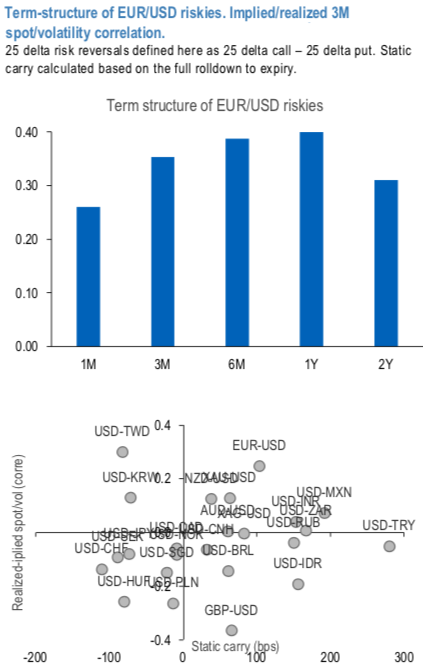The term structure of EURUSD riskies structurally points to a premium for buying EUR topside (refer top chart in 1st diagram). The static carry of the structure benefits from the tight level of riskies (most attractive ones, 2y) and positive forward points associated with the short EURUSD forward position.
However, while the year-end target from FX strategy team still points to strategic upside on the Euro, the performance of such dynamically delta-hedged construct would depend on the joint dynamics between spot and volatility, playing for a rise of the vol during EURUSD rallies; recent research (Long USD skews and correlations offer room for playing Coronavirus hedge trades) suggests that, in risk-off markets, USD dynamics is still consistent with a safe-haven status, which, coupled with the tight levels of USD skews, supports owning (rather than selling) the latter from the spot/vol correlation perspective.
The scatterplot (refer bottom chart in 1st diagram) combines two common metrics, both backward looking: realized-implied spot-vol correlation and static carry. For CHF, MXN, INR and ZAR skews the skew premium setup is conducive, while BRL riskies are still lagging despite cheap pricing and coronavirus-induced risk off markets. Skew performance spiked higher in KRW and TWD on the back of the recent events but the static carry is unfavorable. EUR calls are performing, while also supported by the static carry.
We expand the analysis with 2nd diagram, for supplementing the ex-ante appeal properties with actual long-term performances, a comparison which highlights the challenges of timing the entry into long riskies positions.
The nutshell in the diagram shows some 10y performance measures related to the ownership of riskies (long calls / short put, 3M 25-delta, vol costs included) for USD-crosses. From this long-term analysis, long EURUSD and USDINR delta-hedged riskies display decent performance measures; based on the table, buying CHF calls and selling USD calls worked well historically. Over the past couple of years, the performance of several USD/Asia riskies has delivered flattish PnL, which, coupled with current attractive pricing, should boost the interest for such defensive structures.
The bottom chart of 2nd diagram shows the time series of the static carry for EURUSD, EURINR and USDINR, in all three cases well positioned in positive territory. While the setup looks supportive for buying INR skews, a caveat might be related to the inclination of the Central Bank to control volatility, an issue that can be circumvented (at least to some degree) by playing long-dated tenors, as we do here.
Hence, consider,
Buy 2Y EURUSD risk-reversal (EUR calls – EUR put) @0.275/0.425 indicative, dynamically delta-hedged.
Buy 1Y USDINR risk-reversal (USD calls – USD put) @1.35/1.45 indicative, dynamically delta-hedged.
Buy 1Y USDCHF risk-reversal (CHF calls – CHF put) @1.0/1.2 indicative, dynamically delta- hedged. Courtesy: JPM



 Gold Prices Fall Amid Rate Jitters; Copper Steady as China Stimulus Eyed
Gold Prices Fall Amid Rate Jitters; Copper Steady as China Stimulus Eyed  Moody's Upgrades Argentina's Credit Rating Amid Economic Reforms
Moody's Upgrades Argentina's Credit Rating Amid Economic Reforms  China’s Growth Faces Structural Challenges Amid Doubts Over Data
China’s Growth Faces Structural Challenges Amid Doubts Over Data  Mexico's Undervalued Equity Market Offers Long-Term Investment Potential
Mexico's Undervalued Equity Market Offers Long-Term Investment Potential  Moldova Criticizes Russia Amid Transdniestria Energy Crisis
Moldova Criticizes Russia Amid Transdniestria Energy Crisis  Bank of America Posts Strong Q4 2024 Results, Shares Rise
Bank of America Posts Strong Q4 2024 Results, Shares Rise  Stock Futures Dip as Investors Await Key Payrolls Data
Stock Futures Dip as Investors Await Key Payrolls Data  Gold Prices Slide as Rate Cut Prospects Diminish; Copper Gains on China Stimulus Hopes
Gold Prices Slide as Rate Cut Prospects Diminish; Copper Gains on China Stimulus Hopes  UBS Projects Mixed Market Outlook for 2025 Amid Trump Policy Uncertainty
UBS Projects Mixed Market Outlook for 2025 Amid Trump Policy Uncertainty  Oil Prices Dip Slightly Amid Focus on Russian Sanctions and U.S. Inflation Data
Oil Prices Dip Slightly Amid Focus on Russian Sanctions and U.S. Inflation Data  UBS Predicts Potential Fed Rate Cut Amid Strong US Economic Data
UBS Predicts Potential Fed Rate Cut Amid Strong US Economic Data  U.S. Stocks vs. Bonds: Are Diverging Valuations Signaling a Shift?
U.S. Stocks vs. Bonds: Are Diverging Valuations Signaling a Shift?  Indonesia Surprises Markets with Interest Rate Cut Amid Currency Pressure
Indonesia Surprises Markets with Interest Rate Cut Amid Currency Pressure  Goldman Predicts 50% Odds of 10% U.S. Tariff on Copper by Q1 Close
Goldman Predicts 50% Odds of 10% U.S. Tariff on Copper by Q1 Close  Geopolitical Shocks That Could Reshape Financial Markets in 2025
Geopolitical Shocks That Could Reshape Financial Markets in 2025  China's Refining Industry Faces Major Shakeup Amid Challenges
China's Refining Industry Faces Major Shakeup Amid Challenges  Trump’s "Shock and Awe" Agenda: Executive Orders from Day One
Trump’s "Shock and Awe" Agenda: Executive Orders from Day One 































